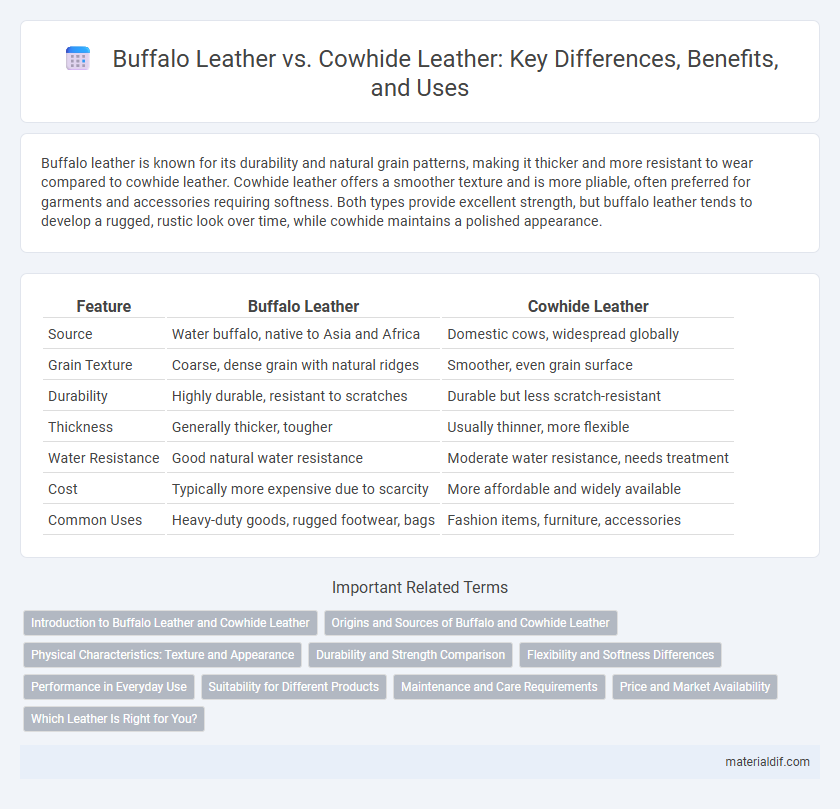Buffalo leather is known for its durability and natural grain patterns, making it thicker and more resistant to wear compared to cowhide leather. Cowhide leather offers a smoother texture and is more pliable, often preferred for garments and accessories requiring softness. Both types provide excellent strength, but buffalo leather tends to develop a rugged, rustic look over time, while cowhide maintains a polished appearance.
Table of Comparison
| Feature | Buffalo Leather | Cowhide Leather |
|---|---|---|
| Source | Water buffalo, native to Asia and Africa | Domestic cows, widespread globally |
| Grain Texture | Coarse, dense grain with natural ridges | Smoother, even grain surface |
| Durability | Highly durable, resistant to scratches | Durable but less scratch-resistant |
| Thickness | Generally thicker, tougher | Usually thinner, more flexible |
| Water Resistance | Good natural water resistance | Moderate water resistance, needs treatment |
| Cost | Typically more expensive due to scarcity | More affordable and widely available |
| Common Uses | Heavy-duty goods, rugged footwear, bags | Fashion items, furniture, accessories |
Introduction to Buffalo Leather and Cowhide Leather
Buffalo leather, derived from the hide of water buffalo, is known for its coarse grain, durability, and natural resistance to water, making it ideal for rugged goods and outdoor gear. Cowhide leather, sourced from cattle, features a finer grain and greater flexibility, widely used in fashion, upholstery, and accessories due to its versatility and smooth texture. Both types offer distinct qualities, with buffalo leather prized for toughness and cowhide for its softness and adaptability.
Origins and Sources of Buffalo and Cowhide Leather
Buffalo leather primarily originates from water buffaloes native to Asia and parts of Africa, prized for its durability and unique grain texture. Cowhide leather, sourced from domesticated cattle worldwide, especially in North and South America, offers a more uniform surface and versatility in applications. Both leathers reflect regional livestock breeding practices influencing their thickness, toughness, and natural markings.
Physical Characteristics: Texture and Appearance
Buffalo leather features a coarser grain with pronounced natural markings, giving it a rugged and textured appearance ideal for durable products. Cowhide leather presents a smoother, more uniform grain with finer texture, resulting in a polished and refined look commonly used in fashion and upholstery. Both types vary in thickness, with buffalo leather generally being thicker and more resistant to wear compared to the softer, more pliable cowhide.
Durability and Strength Comparison
Buffalo leather exhibits greater durability and strength compared to cowhide leather due to its tighter grain structure and higher fiber density, making it more resistant to wear and tear. Buffalo leather's natural oily texture enhances water resistance and flexibility, ideal for heavy-duty applications like bags and footwear. Cowhide leather, while strong and durable, tends to be softer but less resistant to abrasions, making it suitable for lighter use products.
Flexibility and Softness Differences
Buffalo leather features a coarser grain and denser fiber structure, resulting in greater durability but less flexibility compared to cowhide leather. Cowhide leather exhibits a finer texture and softer feel, offering enhanced pliability that molds more comfortably to shapes over time. This difference in fiber density and grain pattern directly influences the softness and flexibility, making cowhide preferable for products requiring supple material and buffalo leather ideal for heavy-duty applications.
Performance in Everyday Use
Buffalo leather offers superior durability and resistance to scratches compared to cowhide leather due to its dense grain structure, making it ideal for heavy everyday use. Cowhide leather is softer and more flexible, providing greater comfort but showing wear more quickly under constant abrasion. Both types exhibit excellent moisture resistance, but buffalo leather maintains its strength and appearance longer in harsh conditions.
Suitability for Different Products
Buffalo leather is thicker and more durable, making it ideal for heavy-duty items like boots, belts, and rugged bags that require long-lasting strength. Cowhide leather offers a smoother texture and greater flexibility, preferred for garments such as jackets, gloves, and high-end accessories that demand softness and comfort. Both leathers serve distinct product needs based on their unique grain structure, toughness, and aging properties.
Maintenance and Care Requirements
Buffalo leather, known for its dense grain and robustness, typically requires less frequent conditioning compared to cowhide leather to maintain its durability and natural oils. Cowhide leather demands more regular cleaning and hydration with specialized leather conditioners to prevent cracking and preserve its softer, more pliable texture. Both types benefit from keeping away from excessive moisture and direct sunlight to extend their lifespan and appearance.
Price and Market Availability
Buffalo leather generally commands a higher price than cowhide leather due to its denser grain and durability, making it a premium choice in the leather market. Cowhide leather enjoys broader market availability, supported by large-scale cattle farming that ensures steady supply and competitive pricing. Buffalo leather's limited supply and niche demand contribute to its higher cost and less widespread presence in mainstream leather products.
Which Leather Is Right for You?
Buffalo leather offers a more rugged texture and greater durability compared to cowhide leather, making it ideal for heavy-use items like work boots and outdoor gear. Cowhide leather provides a smoother finish and more pliability, suited for fashion accessories and upholstery that require flexibility and refined aesthetics. Your choice depends on whether you prioritize toughness and longevity or softness and style in your leather goods.
Buffalo Leather vs Cowhide Leather Infographic

 materialdif.com
materialdif.com